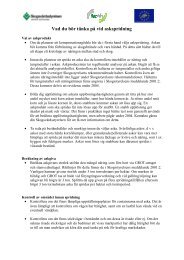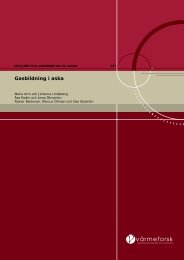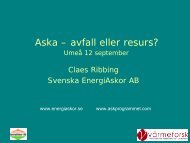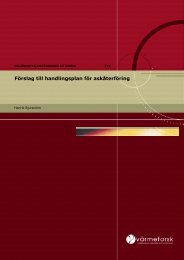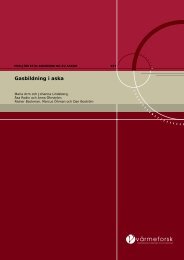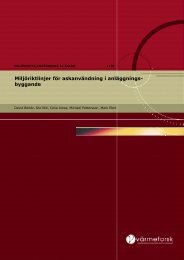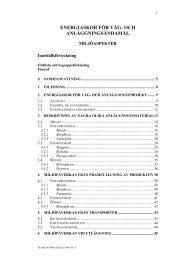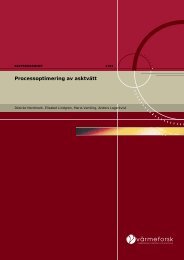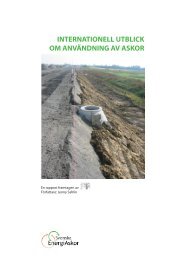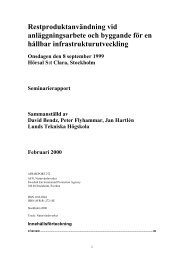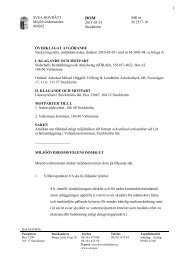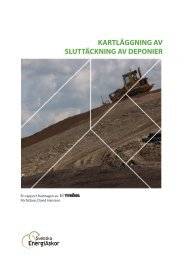rapport 1129 Potentialbedömning av flygaskor ...
rapport 1129 Potentialbedömning av flygaskor ...
rapport 1129 Potentialbedömning av flygaskor ...
Create successful ePaper yourself
Turn your PDF publications into a flip-book with our unique Google optimized e-Paper software.
VÄRMEFORSK<br />
Short English Summary<br />
Over the next few years, about 200 000–800 000 m 3 of contaminated sediments, with a<br />
muddy, slimy texture, high water ratio and low strength, shall be dredged annually in<br />
the development of ports and maintenance dredging of n<strong>av</strong>igable waterways. Dumping<br />
at sea is limited since the dredged materials are contaminated. Land disposal requires<br />
transports and land area and is thus high in costs. In the construction of new port areas,<br />
large volumes of crushed rock, etc. are normally used as construction filling materials.<br />
These materials can be replaced by stabilised and solidified dredged materials, with<br />
modified geotechnical properties. The method of stabilising / solidifying (s/s) contaminated<br />
dredged materials has been used internationally for a long period of time, Holm et<br />
al. (2009) and, in more recent years, even in the Nordic countries. In Sweden, for instance,<br />
the Port of Gävle and the Port of Oxelösund h<strong>av</strong>e received permissions to reuse<br />
s / s-treated contaminated dredged materials in the port structures. Reuse of the stabilised<br />
/ solidified masses in a geotechnical structure is supported by the new Framework<br />
Directive (2008/98/EC) on waste where great emphasis is placed on recycling.<br />
Within the project, fly ashes were inventoried with respect to suitability and<br />
<strong>av</strong>ailability. Five fly ashes, both individual fly ashes and mixtures of different fly ashes,<br />
were investigated in the laboratory as a binder component in a binder mix consisting of<br />
50% cement, 20% Merit 5000 and 30% fly ash. Sediment from the Port of Gävle were<br />
stabilised with a binder mixture amount of 150 kg/m 3 . Produced samples were<br />
examined in terms of strength, permeability and leaching. An assessment of the fly<br />
ashes’ potential was performed based on technological, environmental and economical<br />
aspects, as well as market demand and the acceptance of stabilised and solidified<br />
dredged materials as construction material.<br />
The results show that fly ash, together in a binder mixture with construction cement and<br />
Merit 5000, has good potential as a binder. There is a clear correlation between the CaO<br />
content of fly ashes and compressive strength of the stabilised samples, whereas maximum<br />
compressive strength was obtained with the fly ash with a maximum content of<br />
CaO. All stabilised samples passed the basic criterion of compressive strength > 140<br />
kPa, with the lowest value being 300 kPa and with a median of just over 500 kPa after<br />
91 days. The samples had a low permeability between 10 -8 m / s and 10 -9 m / s.<br />
Leaching tests showed that the stabilised material’s leaching of metals was low and that<br />
organic pollutants were barely detectable. A binder mixture with 30% fly ash provides a<br />
cost reduction of the binder of approximately 25%.<br />
High standards are required for port constructions, which means high demands on the<br />
quality of the binders used in the stabilisation and solidification processes. Therefore, a<br />
sturdy binder mixture that is capable of handling a variation in the quality of fly ash and<br />
sediment materials, plus a variation in the binder quantity involved in the stabilised<br />
material. The need for large volumes of binders means that binder suppliers must cooperate<br />
and that the logistics needed to ensure delivery of fly ash in an s / s project is a<br />
process that requires good preparation.<br />
vi



